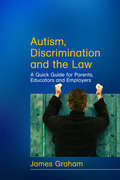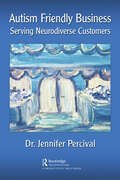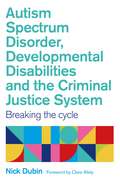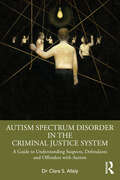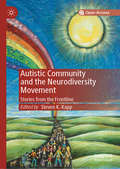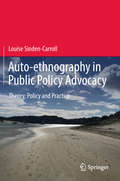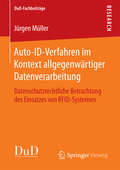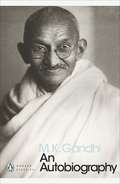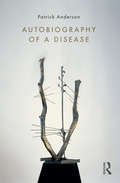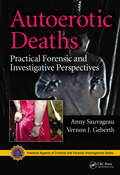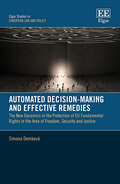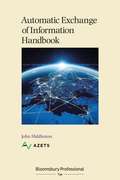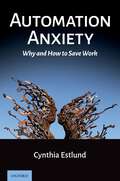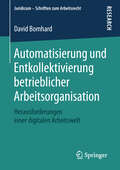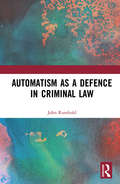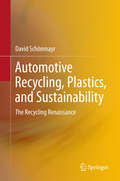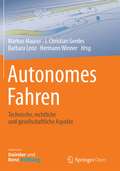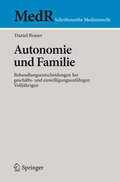- Table View
- List View
Autism, Discrimination and the Law: A Quick Guide for Parents, Educators and Employers (PDF)
by James Graham Nick GrahamAutism, Discrimination and the Law outlines how the legal requirements of the Disability Discrimination Act 1995 might be met for students and employees with autism spectrum disorders (ASDs). * What might discrimination against people with autism look like? * What can you do to prevent discrimination against people with autism? * What should you do if you have been discriminated against? The book includes an overview of current knowledge of autism, and details of the changes in legislation concerning disability discrimination. The main part of the book is devoted to case studies from further education and employment demonstrating how reasonable adjustments can be made successfully. This accessible book will be an essential reference for employers, policy makers, Local Education Authorities, Learning and Skills Councils, Training providers, schools and colleges, personnel officers, careers officers, charities, residential homes, parents, indeed anyone working with people with autistic spectrum disorders.
Autism Friendly Business: Neurodiverse Customers (Autism Friendly)
by Jennifer PercivalDesigned as a guidebook for leaders at the beginning of their journey embracing neuroinclusion, Autism Friendly Business: Neurodiverse Customers will provide business owners, executives, managers, team members, and associates the tools to integrate strategies and techniques that will enhance their business, while improving the delivery of a quality experience for all. Autistic individuals often experience barriers when engaging with businesses. This book provides solutions and examples on how leaders can remove obstacles to develop supportive and inclusive environments.
Autism Friendly Business: Neurodiverse Customers (Autism Friendly)
by Jennifer PercivalDesigned as a guidebook for leaders at the beginning of their journey embracing neuroinclusion, Autism Friendly Business: Neurodiverse Customers will provide business owners, executives, managers, team members, and associates the tools to integrate strategies and techniques that will enhance their business, while improving the delivery of a quality experience for all. Autistic individuals often experience barriers when engaging with businesses. This book provides solutions and examples on how leaders can remove obstacles to develop supportive and inclusive environments.
Autism Spectrum Disorder, Developmental Disabilities, and the Criminal Justice System: Breaking the Cycle
by Nick DubinFor autistic people who find themselves facing a criminal charge, understanding how the features of autism may have contributed to their behaviour can be vital context for their defence. In this insightful book, Nick Dubin explores how and why autistic people get caught up in the criminal justice system. He delves into what steps can be taken to prevent autistic people committing crimes and what should be done to ensure their fair and appropriate treatment if they are charged with a crime. It covers everything from prevention to the aftermath of sentencing, including available counselling and therapy. Nick's personal experience and meticulous research shows that criminal justice can be an oppressive system that misunderstands and stigmatizes autistic people, especially low-risk individuals and those with less criminal responsibility.
Autism Spectrum Disorder, Developmental Disabilities, and the Criminal Justice System: Breaking the Cycle
by Nick DubinFor autistic people who find themselves facing a criminal charge, understanding how the features of autism may have contributed to their behaviour can be vital context for their defence. In this insightful book, Nick Dubin explores how and why autistic people get caught up in the criminal justice system. He delves into what steps can be taken to prevent autistic people committing crimes and what should be done to ensure their fair and appropriate treatment if they are charged with a crime. It covers everything from prevention to the aftermath of sentencing, including available counselling and therapy. Nick's personal experience and meticulous research shows that criminal justice can be an oppressive system that misunderstands and stigmatizes autistic people, especially low-risk individuals and those with less criminal responsibility.
Autism Spectrum Disorder in the Criminal Justice System: A Guide to Understanding Suspects, Defendants and Offenders with Autism
by Dr Clare AllelyThis book focuses on autism spectrum disorder (ASD) in the criminal justice system. Rather than being the perpetrators of offending, individuals with ASD are more likely to be the victim of crime. However, there is nevertheless a small subset of individuals with ASD who do offend, and this book provides an in-depth understanding of how certain features of ASD may provide the context of vulnerability to engaging in a number of types of offending behaviours. Chapters focus on arson or fire-setting; cybercrime (e.g., hacking); online sexual offending such as the viewing of indecent child imagery; offline sexual offending; violent crime; stalking; terroristic behaviour (including radicalisation and extremism); bestiality or zoophilia and also extreme violence such as mass shooting and serial homicide. This book also outlines the ways in which a defendant with ASD may present in court and how they may exhibit behaviour which could be misinterpreted and perceived negatively leading to an unfair trial. Lastly, it discusses the need to identify the impact that ASD can have on the capacity to form the requisite criminal intent and offer appropriate court adaptions to support them during court proceedings. This book is ideal for criminal defense lawyers and practitioners in psychology, psychiatry, and social work as well as policy makers and reformers.
Autism Spectrum Disorder in the Criminal Justice System: A Guide to Understanding Suspects, Defendants and Offenders with Autism
by Dr Clare AllelyThis book focuses on autism spectrum disorder (ASD) in the criminal justice system. Rather than being the perpetrators of offending, individuals with ASD are more likely to be the victim of crime. However, there is nevertheless a small subset of individuals with ASD who do offend, and this book provides an in-depth understanding of how certain features of ASD may provide the context of vulnerability to engaging in a number of types of offending behaviours. Chapters focus on arson or fire-setting; cybercrime (e.g., hacking); online sexual offending such as the viewing of indecent child imagery; offline sexual offending; violent crime; stalking; terroristic behaviour (including radicalisation and extremism); bestiality or zoophilia and also extreme violence such as mass shooting and serial homicide. This book also outlines the ways in which a defendant with ASD may present in court and how they may exhibit behaviour which could be misinterpreted and perceived negatively leading to an unfair trial. Lastly, it discusses the need to identify the impact that ASD can have on the capacity to form the requisite criminal intent and offer appropriate court adaptions to support them during court proceedings. This book is ideal for criminal defense lawyers and practitioners in psychology, psychiatry, and social work as well as policy makers and reformers.
Autistic Community and the Neurodiversity Movement: Stories from the Frontline
by Steven K. KappThis open access book marks the first historical overview of the autism rights branch of the neurodiversity movement, describing the activities and rationales of key leaders in their own words since it organized into a unique community in 1992. Sandwiched by editorial chapters that include critical analysis, the book contains 19 chapters by 21 authors about the forming of the autistic community and neurodiversity movement, progress in their influence on the broader autism community and field, and their possible threshold of the advocacy establishment. The actions covered are legendary in the autistic community, including manifestos such as “Don’t Mourn for Us”, mailing lists, websites or webpages, conferences, issue campaigns, academic project and journal, a book, and advisory roles. These actions have shifted the landscape toward viewing autism in social terms of human rights and identity to accept, rather than as a medical collection of deficits and symptoms to cure.
Auto-ethnography in Public Policy Advocacy: Theory, Policy and Practice
by Louise Sinden-CarrollThis book explores how public policy advocacy can be used to approach policy issue identification, resolution or, at the least, support the management of wicked policy issues. By describing how this type of advocacy draws on participatory action research, including ethnographic and auto-ethnographic models, this book offers a tool for public policy consumer advocates on how to apply the Human Capabilities Approach to address presenting public policy issues worldwide. By applying these models to the situation of prisoners with hearing loss in New Zealand’s prisons, it identifies multiple causal factors for quality-of-life-limiting marginalization, e.g. social barriers (e.g. disability discrimination); environmental limitations (e.g. geographical and those introduced by incarceration); and individual responses in line with negative attitudes – both social and political, including the State’s denial of prisoners’ right to democratic participation by revoking their right to vote in general elections after sentencing. In addition, two other areas, namely blood safety and broadcast media captioning, are highlighted, showing that the skill of auto-ethnography is transferrable and can be applied to ensure effective consumer advocacy for a diverse range of issues that affect marginalized sectors.
Auto-ID-Verfahren im Kontext allgegenwärtiger Datenverarbeitung: Datenschutzrechtliche Betrachtung des Einsatzes von RFID-Systemen (DuD-Fachbeiträge)
by Jürgen MüllerAm Beispiel von RFID-Systemen werden die datenschutzrechtlichen Anforderungen an den Einsatz von Auto-ID-Verfahren unter den Bedingungen des ‚Ubiquitous Computing‘ untersucht. Differenziert nach Funktionsbereichen des RFID-Vorder- und RFID-Hintergrundsystems erläutert der Autor Bedingungen und Herausforderungen bei Vorgängen des Datenumgangs, bei der Verantwortlichkeit, den Zulässigkeitstatbeständen, den besonderen Transparenzanforderungen oder bei Betroffenenrechten. Dabei werden die Grenzen des geltenden Datenschutzrechts ausgelotet und Ansätze für dessen Weiterentwicklung vor dem Hintergrund einer sich zunehmend informatisierenden Welt diskutiert.
An Autobiography: The Story Of My Experiments With Truth (Penguin Modern Classics)
by M. K Gandhi Sunil KhilnaniGandhi's non-violent struggles against racism, violence, and colonialism in South Africa and India had brought him to such a level of notoriety, adulation that when asked to write an autobiography midway through his career, he took it as an opportunity to explain himself. He feared the enthusiasm for his ideas tended to exceed a deeper understanding of his quest for truth rooted in devotion to God. His attempts to get closer to this divine power led him to seek purity through simple living, dietary practices, celibacy, and a life without violence. This is not a straightforward narrative biography, in The Story of My Experiments with Truth, Gandhi offers his life story as a reference for those who would follow in his footsteps.
Autobiography of a Disease (Writing Lives: Ethnographic Narratives)
by Patrick AndersonAutobiography of a Disease documents, in experimental form, the experience of extended life-threatening illness in contemporary US hospitals and clinics. The narrative is based primarily on the author’s sudden and catastrophic collapse into a coma and long hospitalization thirteen years ago; but it has also been crafted from twelve years of research on the history of microbiology, literary representations of illness and medical treatment, cultural analysis of MRSA in the popular press, and extended autoethnographic work on medicalization. An experiment in form, the book blends the genres of storytelling, historiography, ethnography, and memoir. Unlike most medical memoirs, told from the perspective of the human patient, Autobiography of a Disease is told from the perspective of a bacterial cluster. This orientation is intended to represent the distribution of perspectives on illness, disability, and pain across subjective centers—from patient to monitoring machine, from body to cell, from caregiver to cared-for—and thus makes sense of illness only in a social context.
Autobiography of a Disease (Writing Lives: Ethnographic Narratives)
by Patrick AndersonAutobiography of a Disease documents, in experimental form, the experience of extended life-threatening illness in contemporary US hospitals and clinics. The narrative is based primarily on the author’s sudden and catastrophic collapse into a coma and long hospitalization thirteen years ago; but it has also been crafted from twelve years of research on the history of microbiology, literary representations of illness and medical treatment, cultural analysis of MRSA in the popular press, and extended autoethnographic work on medicalization. An experiment in form, the book blends the genres of storytelling, historiography, ethnography, and memoir. Unlike most medical memoirs, told from the perspective of the human patient, Autobiography of a Disease is told from the perspective of a bacterial cluster. This orientation is intended to represent the distribution of perspectives on illness, disability, and pain across subjective centers—from patient to monitoring machine, from body to cell, from caregiver to cared-for—and thus makes sense of illness only in a social context.
Autoerotic Deaths: Practical Forensic and Investigative Perspectives
by Anny Sauvageau Vernon J. GeberthAutoerotic Deaths: Practical Forensic and Investigative Perspectives is a collaboration between two internationally known experts who combine their extensive experience to present a scientific, modern view of autoerotic death complete with a wide variety of exquisite case histories, photographs, and investigator tips.Chief Medical Examiner Anny Sau
Automated Decision-Making and Effective Remedies: The New Dynamics in the Protection of EU Fundamental Rights in the Area of Freedom, Security and Justice (Elgar Studies in European Law and Policy)
by Simona DemkováThis timely book explores the legal and practical challenges created by the increasingly automated decision-making procedures underpinning EU multilevel cooperation, for example, in the fields of border control and law enforcement. It argues that such procedures impact not only the rights to privacy and data protection, but fundamentally challenge the EU constitutional promise of effective judicial protection.Focusing on informational cooperation in the EU Area of Freedom, Security and Justice, this book examines the extent to which the EU’s system of remedies allows individuals to enforce their rights against automated decisions – such as in cases of the rejection of a residence permit application or the execution of search warrants. Concluding that enforcement of rights is difficult to achieve, the book calls for the comprehensive legal empowerment of individuals through a deep procedural review of automated decision-making. It advances the academic and policy debate on human-centric digital innovation, presenting an empirical case for greater scrutiny of the uses of new technology.The book will be a fascinating read for scholars and students of European law, the law of technology, and human rights. It will also be a useful guide for human and digital rights organisations, policy-makers, and judges seeking to empower individuals in the age of automation.
Automatic Exchange of Information Handbook
by John HiddlestonAutomatic Exchange of Information Handbook is a practical guide to the automatic exchange of information rules legislation within the UK. Covering the requirements of the OECD Common Reporting Standard (CRS), and the US Foreign Account Tax Compliance Act (FATCA) on financial institutions, this title helps to explain: - What the key jargon means- How to work out the status of an organisation under these rules (the definition of financial institutions may include professional firms, charities and trusts)- The potential penalties and other risks of non-compliance and how to minimise those risks- How to achieve compliance, including: - How to carry out the required due diligence- How to make a reportThe title summarises a brief history of AEOI, the impact of Brexit, who is affected and how, due diligence requirements, and more, as well as other issues including other forms of international information exchange such as anti-money laundering rules and bi-lateral double taxation treaties. Key points are clearly highlighted throughout for easy references and flowcharts are included to support some areas of commentary. This title is essential for tax advisers, accountants, tax lawyers, financial advisers and students studying for international tax qualifications. It will also be relevant for finance and management teams in organisations which fall under these rules in practice.
Automation Anxiety: Why and How to Save Work
by Cynthia EstlundAre super-capable robots and algorithms destined to devour our jobs and idle much of the adult population? Predictions of a jobless future have recurred in waves since the advent of industrialization, only to crest and retreat as new jobs-usually better ones-have replaced those lost to machines. But there's good reason to believe that this time is different. Ongoing innovations in artificial intelligence, machine learning, and robotics are already destroying more decent middle-skill jobs than they are creating, and may be leading to a future of growing job scarcity. But there are many possible versions of that future, ranging from utterly dystopian to humane and broadly appealing. It all depends on how we respond. This book confronts the hotly-debated prospect of mounting job losses due to automation, and the widely-divergent hopes and fears that prospect evokes, and proposes a strategy for both mitigating the losses and spreading the gains from shrinking demand for human labor. We should set our collective sights, it argues, on ensuring access to adequate incomes, more free time, and decent remunerative work even in a future with less of it. Getting there will require not a single "magic bullet" solution like universal basic income or a federal job guarantee but a multi-pronged program centered on conserving, creating, and spreading work. What the book proposes for a foreseeable future of less work will simultaneously help to address growing economic inequality and persistent racial stratification, and makes sense here and now but especially as we face the prospect of net job losses.
Automation Anxiety: Why and How to Save Work
by Cynthia EstlundAre super-capable robots and algorithms destined to devour our jobs and idle much of the adult population? Predictions of a jobless future have recurred in waves since the advent of industrialization, only to crest and retreat as new jobs-usually better ones-have replaced those lost to machines. But there's good reason to believe that this time is different. Ongoing innovations in artificial intelligence, machine learning, and robotics are already destroying more decent middle-skill jobs than they are creating, and may be leading to a future of growing job scarcity. But there are many possible versions of that future, ranging from utterly dystopian to humane and broadly appealing. It all depends on how we respond. This book confronts the hotly-debated prospect of mounting job losses due to automation, and the widely-divergent hopes and fears that prospect evokes, and proposes a strategy for both mitigating the losses and spreading the gains from shrinking demand for human labor. We should set our collective sights, it argues, on ensuring access to adequate incomes, more free time, and decent remunerative work even in a future with less of it. Getting there will require not a single "magic bullet" solution like universal basic income or a federal job guarantee but a multi-pronged program centered on conserving, creating, and spreading work. What the book proposes for a foreseeable future of less work will simultaneously help to address growing economic inequality and persistent racial stratification, and makes sense here and now but especially as we face the prospect of net job losses.
Automatisierung und Entkollektivierung betrieblicher Arbeitsorganisation: Herausforderungen einer digitalen Arbeitswelt (Juridicum - Schriften zum Arbeitsrecht)
by David BomhardDavid Bomhard untersucht in diesem Buch die Veränderung der Arbeitswelt durch Automatisierung und Digitalisierung hin zur „Arbeitsorganisation 4.0“. Im Zentrum stehen zwei Digitalisierungs-Aspekte: Einerseits kann Automatisierung von Arbeitgeberentscheidungen den Arbeitnehmer zum Objekt einer „Maschinenherrschaft“ machen. Andererseits wird die Arbeitsorganisation instabiler und fragmentarischer, was die Kollektive des kollektiven Arbeitsrechts bedroht, vor allem aber den Betrieb als Grundeinheit der Betriebsverfassung. Der digitale Wandel kann ohne eine wechselseitige Berücksichtigung technischer und rechtliche Aspekte nicht verstanden werden. Der Autor sucht diese Synthese.
Automatism as a Defence
by John RumboldAutomatism is a notoriously difficult subject for law students, lawyers and judges. This book explores the science and medicine of sleep disorders and examines how the criminal process deals with such disorders when presented as a defence. It systematically examines the legal doctrines involved, and their implications for the use of the evidence key to establishing automatism, while also exploring the medical conditions that can cause automatism (particularly epilepsy, sleepwalking and diabetes). This book is a valuable resource for law students, lawyers, judges and expert witnesses.
Automatism as a Defence
by John RumboldAutomatism is a notoriously difficult subject for law students, lawyers and judges. This book explores the science and medicine of sleep disorders and examines how the criminal process deals with such disorders when presented as a defence. It systematically examines the legal doctrines involved, and their implications for the use of the evidence key to establishing automatism, while also exploring the medical conditions that can cause automatism (particularly epilepsy, sleepwalking and diabetes). This book is a valuable resource for law students, lawyers, judges and expert witnesses.
Automotive Recycling, Plastics, and Sustainability: The Recycling Renaissance
by David SchönmayrThis book provides transdisciplinary analyses of the automotive plastics production and recycling system, including prognoses, scenarios and solutions for corporate sustainability management.A book on plastics, not written by a plastics guy. But a sustainability guy. Plastics schizophrenia and the automotive abyss: The industry is facing a severe challenge. It is the inevitable and promising change towards a sustainable economy. However, the automotive industry is primarily concerned with the CO2 emissions from cars when driving, while the rise of lightweight plastics, electric drive and heavy batteries make the production and end-of-life phase ever more important. Therefore, the currently increasing use of non-sustainable virgin plastics in cars has to be tackled.The plastics and the automotive industry now have a chance, and this chance is the Recycling Renaissance.This book offers:• Holistic and transdisciplinary overview on sustainability and automotive plastics from all angles including economy, ecology, technology, and politics with a focus on Europe• Concise analyses, prognoses, tools and a roadmap with solutions for companies, developed together with international experts from industry and academia • Strong scientific basis and independent research including a Europe-wide survey, expert interviews, and workshops• More than 80 illustrations and 15 tables including a SCOT analysis • Executive summaries after each chapter for fast reading“The uniqueness of this book lies within the different point of view on this topic from a critical, outstanding scientist.” - Univ.-Prof. Dipl.-Ing. Dr.mont. Pomberger, Montanuni Leoben
Autonomes Fahren: Technische, rechtliche und gesellschaftliche Aspekte
Ist das voll automatisierte, autonom fahrende Auto zum Greifen nah? Testfahrzeuge und Zulassungen in den USA erwecken diesen Eindruck, werfen aber gleichzeitig viele neue Fragestellungen auf. Wie werden autonome Fahrzeuge in das aktuelle Verkehrssystem integriert? Wie erfolgt ihre rechtliche Einbettung? Welche Risiken bestehen und wie wird mit diesen umgegangen? Und welche Akzeptanz seitens der Gesellschaft sowie des Marktes kann hinsichtlich dieser Entwicklungen überhaupt erwartet werden?Das vorliegende Buch gibt Antworten auf ein breites Spektrum dieser und weiterer Fragen. Expertinnen und Experten aus Deutschland und den USA beschreiben aus ingenieur- und gesellschaftswissenschaftlicher Sicht zentrale Themen im Zusammenhang mit der Automatisierung von Fahrzeugen im öffentlichen Straßenverkehr. Sie zeigen auf, welche „Entscheidungen“ einem autonomen Fahrzeug abverlangt werden beziehungsweise welche „Ethik“ programmiert werden muss. Die Autorinnen und Autoren diskutieren Erwartungen und Bedenken, die die individuelle wie auch die gesellschaftliche Akzeptanz des autonomen Fahrens kennzeichnen. Ein durch autonome Fahrzeuge erhöhtes Sicherheitspotenzial wird den Herausforderungen und Lösungsansätzen, die bei der Absicherung des Sicherheitskonzeptes eine Rolle spielen, gegenübergestellt. Zudem erläutern sie, welche Veränderungsmöglichkeiten und Chancen sich für unsere Mobilität und die Neuorganisation des Verkehrsgeschehens ergeben, nicht zuletzt auch für den Güterverkehr. Das Buch bietet somit eine aktuelle, umfassende und wissenschaftlich fundierte Auseinandersetzung mit dem Thema „Autonomes Fahren“.
Autonomie: Maßstab, Ideal oder Illusion? Vadian Lectures Band 9 (Sozialtheorie)
by Mathias Lindenau Marcel Meier KressigAutonomie und mit ihr die Selbstbestimmung gelten als hohes Gut. Demnach hat jeder Mensch das Recht, selbst darüber zu entscheiden, wie er leben möchte, und seine persönlichen Entscheide in der eigenen Lebensführung zu realisieren - und das ohne die Einmischung von anderen, auch staatlichen Stellen. Doch Selbstbestimmung ist nicht grenzenlos. Sie hat auch Rücksicht auf andere zu nehmen, deren Rechte zu achten und ist immer mit Verantwortung verbunden. Die Beiträger*innen des Bandes stellen sich diesem Spannungsfeld und fragen: Was heißt es unter diesen Vorzeichen, sich selbst zu bestimmen und ein gelungenes Leben zu führen? Und was bedeutet Autonomie für Entscheide am Lebensende und die personalisierte Medizin?
Autonomie und Familie: Behandlungsentscheidungen bei geschäfts- und einwilligungsunfähigen Volljährigen (MedR Schriftenreihe Medizinrecht)
by Daniel BrauerBeiträge zur Patientenautonomie gibt es viele. Was bisher aber kaum Beachtung gefunden hat, ist das Verhältnis zwischen Patientenautonomie und der Familie als personellem Nahraum. Das vorliegende Buch schließt diese Lücke, indem es die Bedeutung von Familienangehörigen bei medizinischen Entscheidungssituationen geschäfts- und einwilligungsunfähiger Patienten untersucht. Der Autor bereitet die Thematik systematisch auf, indem er, ausgehend von einer Darstellung eines Autonomiekonzepts und den Grundlagen der medizinischen Behandlung, der Kernfrage nachgeht, wie die Familie in den Entscheidungsfindungsprozess einbezogen wird und warum. Aufbauend auf diesen Erkenntnissen untersucht der Autor, ob aus der Einbeziehung der Familie eine Gefährdung für die Autonomie des Einzelnen folgt. Abschließend wendet sich der Autor der Beteiligung von Familienmitgliedern in den Rechtsordnungen der USA und den sich aus einem Rechtsvergleich ergebenden Handlungsimpulsen für das deutsche Recht zu.
